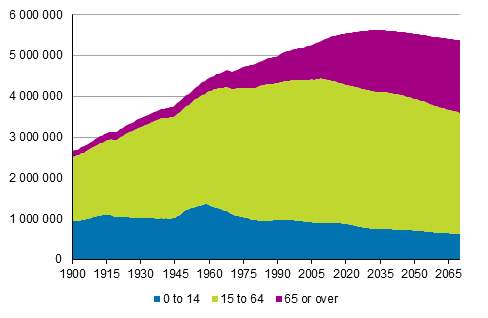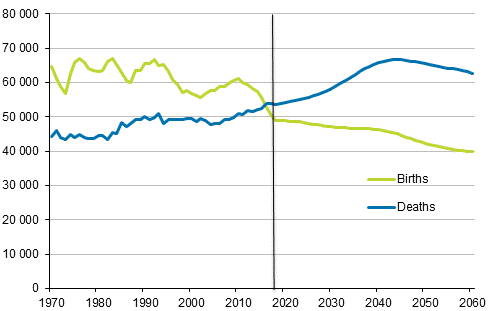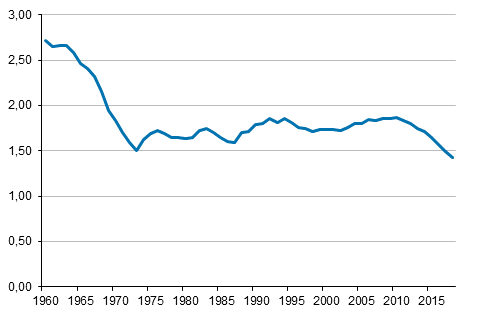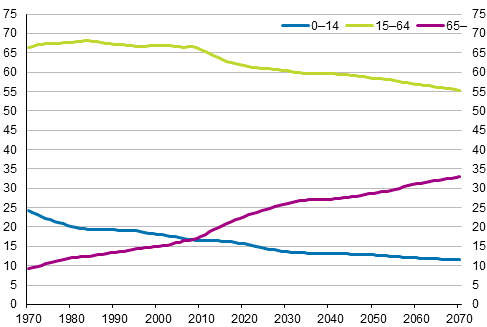Published: 16 November 2018
Number of young people in danger of diminishing considerably due to the decrease in birth rate
According to Statistics Finland's latest population projection, there would be 760,000 persons aged under 15 in Finland in 2030, if the birth rate remains at the current level. In the 2050s the number would already drop under 700,000 young people. In Finland the number of persons aged under 15 has last been this low at the end of the 1870s, when Finland’s population was less than two million. In the 1970s there were still one million persons aged under 15 in Finland.
Population by age 1900–2017 and projection 2018–2070

Population is projected to turn to a decline in 2035
The year 2018 will be the third year in a row when deaths exceed births in Finland. According to the projection, the number of births will continue to decrease and the number of deaths will increase despite the lengthened life expectancy. According to the projection, net immigration would sustain population growth until 2035, when Finland’s population would be 5.62 million. After this, population would turn to a decline and in the 2050s Finland’s population would already be below the current number, according to the projection.
Number of births and deaths 1970–2017 and projected number 2018–2060

Birth rate diminished by one-fifth in seven years
The total fertility rate, which describes the birth rate level, was 1.87 in Finland in 2010. Last year the total fertility rate was at its lowest in Finland’s history, 1.49. The birth rate has diminished by 20 per cent. The year 2018 will be the eighth year in a row when the birth rate decreases in Finland. According to the estimate, the total fertility rate will be 1.43 this year. The birth rate has last diminished this many years in a row in Finland in the 1960s.
Total fertility rate 1960–2018*

*) 2018 estimate
Decrease in birth rate is reflected in the population of working age at a delay
The number of the population of working age has fallen by 100,000 persons during the last eight years in Finland. According to the projection, the population of working age is expected to decrease by 57,000 persons by 2030 from the present. The proportion of people of working age (persons aged15 to 64) in the population would diminish from the present 62 per cent to 60 per cent by 2030 and to 58 per cent by 2050. In 2050, the population of working age will have decreased by good 200,000 from the present.
The so-called self-sufficiency forecast describes a situation where there would be no immigration and emigration at all and only the birth rate and mortality would influence the age structure. According to the self-sufficiency forecast, the number of people of working age would go down by the year 2030 by 217,000 persons and by the year 2050 by 630,000 persons.
Age groups’ share of the population 1970–2017 and projected share 2018–2070, per cent

Demographic dependency ratio weakens more slowly than in earlier projections
The demographic dependency ratio, that is, the number of persons aged 15 or under and 65 or over per 100 working age persons was 60 at the end of 2017. According to the projection, the dependency ratio will rise in future decades, but more slowly than in earlier projections. The reason for this is the decrease in birth rate and as a result, the decrease in number of young dependants. In 2020 the dependency ratio would be 62, in 2030, 66 and in 2050, 71. In the short term, the demographic dependency ratio weakens more slowly than in earlier projections.
In the long term, the demographic dependency ratio weakens more than in earlier projections. In 2070, the demographic dependency ratio is projected to be 81.
Assumptions of the 2018 population projection
Statistics Finland's latest population projection assumes that the birth rate would remain constant in future. The imputed number of children that women give birth to during their lifetime, i.e. the total fertility rate, is assumed to be 1.45.
The projection also assumes that net immigration to Finland will be 15,000 persons per year. Mortality is assumed to continue declining similarly to what has been detected when comparing the mortality for 1987 to 1991 and 2013 to 2017.
Regional projection will be published in autumn 2019
The compilation of regional population projection is postponed to autumn 2019. The regional projection will not be compiled in autumn 2018, because the migration statistics for 2017 were not available in time to compile the projection. Statistics Finland did not want to compile a regional population projection based on outdated migration statistics. In this case, the latest observed regional development in migration would have been left unnoticed and unanalysed.
The projection is a trend calculation and gives decision-makers a chance to react
Statistics Finland’s population projections are demographic trend calculations based on observations on past development in the birth rate, mortality and migration. The projections do not seek to estimate the effect of economic, socio-political regional policy and other such factors on population development.
According to the character of trend calculations, the projection expects past developments to continue into the future. The projections do not take a stand on how the size of the population should develop. Therefore, population projection figures should be examined bearing in mind that the projection only indicates the expected population development if the past development continues unchanged into the next decades.
The task of a population projection is to provide tools with which decision-makers can assess whether measures need to be taken to try to influence the population development. Decision-makers should assess the advisability of the population development indicated by the projection and, if necessary, take action to prevent the materialisation of the projection if the population development indicated by the projection is not desired.
Source: Population and Justice Statistics. Statistics Finland
Inquiries: Markus Rapo 029 551 3238, vaesto.tilasto@stat.fi
Director in charge: Jari Tarkoma
Publication in pdf-format (287.8 kB)
- Tables
-
Tables in databases
Pick the data you need into tables, view the data as graphs, or download the data for your use.
Appendix tables
- Appendix table 1. Population by age 1900 - 2070 (years 2020 to 2070: projection) Corrected on 18 December 2018 (16.11.2018)
- Appendix table 2. Population and demographic dependency ratio at the end of 2030 in population projections compiled in different years (16.11.2018)
- Appendix table 3. Demographic dependency ratio and population in 1970 to 2070 (years 2020 to 2070: projection) (16.11.2018)
- Figures
-
- Appendix figure 1. Demographic depedency ratio 1970 - 2060 (16.11.2018)
- Appendix figure 2. Difference in age specific fertility rates year 2017 compared to 2010, per cent (16.11.2018)
- Appendix figure 3. Population by age and gender 2017 (16.11.2018)
- Appendix figure 4. Population by age and gender 2040, projection 2018 (16.11.2018)
- Quality descriptions
Updated 16.11.2018
Official Statistics of Finland (OSF):
Population projection [e-publication].
ISSN=1798-5153. 2018. Helsinki: Statistics Finland [referred: 19.4.2025].
Access method: http://stat.fi/til/vaenn/2018/vaenn_2018_2018-11-16_tie_001_en.html

